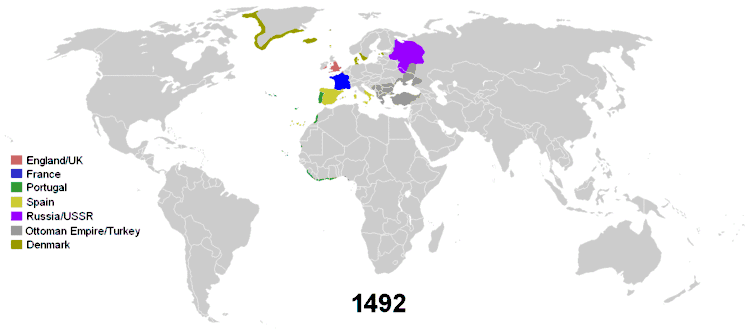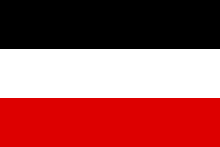Colonial empire
The colonial empires began with a race of exploration between the then most advanced maritime powers, Portugal and Spain, during the 15th century. The initial impulse behind these dispersed maritime empires and those that followed was trade, driven by the new ideas and the capitalism that grew out of the European Renaissance. Agreements were also made to divide the world up between them in 1479, 1493, and 1494. European imperialism was born out of competition between European Christians and Ottoman Muslims, the latter of which rose up quickly in the 14th century and forced the Spanish and Portuguese to seek new trade routes to China.
European colonial empires
Portugal began establishing the first global trade network and empire under the leadership of Henry the Navigator. The empire spread throughout a vast number of territories distributed across the globe (especially at one time in the 16th century) that are now parts of 60 different sovereign states. Portugal would eventually control Brazil, territories such as what is now Uruguay and some fishing ports in north, in the Americas; Angola, Mozambique, Portuguese Guinea, and São Tomé and Príncipe (among other territories and bases) in the North and the Subsaharan Africa; cities, forts or territories in all the Asian Subcontinents, as Muscat, Ormus and Bahrain (amongst other bases) in the Persian Gulf; Goa, Bombay and Daman and Diu (amongst other coastal cities) in India; Portuguese Ceylon; Malacca, bases in Southeast Asia and Oceania, as Makassar, Solor, Banda, Ambon and others in the Moluccas, Portuguese Timor; and the granted entrepôt-base of Macau and the entrepôt-enclave of Dejima (Nagasaki) in East Asia, amongst other smaller or short-lived possessions.

During its Siglo de Oro, the Spanish Empire had possession of the Netherlands, Luxembourg, Belgium, most of Italy, parts of Germany, parts of France, and many colonies in the Americas, Africa, and Asia. With the conquest of inland Mexico, Peru, and the Philippines in the 16th century, Spain established overseas dominions on a scale that had never been approached by its predecessors (the Mongol Empire had been larger but was restricted to Eurasia), and with the Iberian Union (1580), reached the widest scale in history until then in world distribution. Possessions in Europe, Africa, the Atlantic Ocean, the Americas, the Pacific Ocean, and East Asia qualified the Spanish Empire as attaining a global presence.
From 1580 to 1640 the Portuguese Empire and the Spanish Empire were conjoined in a personal union of its Habsburg monarchs during the period of the Iberian Union, but beneath the highest level of government, their separate administrations were maintained.
Subsequent colonial empires included the French, English, Dutch and Japanese empires. By the mid-17th century, the Tsardom of Russia, continued later as the Russian Empire and the Soviet Union, became the largest contiguous state in the world, and the modern Russian Federation continues to be so to this day. Russia today has nine time zones, stretching across about half of the world's longitude.

The British Empire, consolidated during the period of British maritime hegemony in the 19th century, became the largest empire in history by virtue of the improved transportation technologies of the time. At its height, the British Empire covered a quarter of the Earth's land area and comprised a quarter of its population. During the New Imperialism, Italy and Germany also built their colonial empires in Africa.
After the Boxer Rebellion in 1901, Imperial China made concessions to the Eight-Nation Alliance (all the Great Powers of the time). By the end of the 20th century most of the previous colonial empires had been decolonized.
List of colonial empires
-
 Portuguese Empire (1415–2002)
Portuguese Empire (1415–2002)
-
 Spanish Empire (1492–1975)
Spanish Empire (1492–1975)
- Spanish colonization of the Americas
- Spanish East Indies (1565–1898)
- Spanish Guinea (1778–1968)
- Spanish Sahara (1884–1975)
- Spanish protectorate in Morocco (1912–1956)
-
 French Empire (1534–present)
French Empire (1534–present)
- Kingdom of France (1534–1792)
- First French Empire of Napoleon I (1804–1814 or 1815)
- Second French Empire of Napoleon III (1852–1870)
- French colonization of the Americas
- List of colonies and possessions of France
- Tsardom of Russia,
.svg.png) Russian Empire,
Russian Empire,  Soviet Union, and
Soviet Union, and  Russian Federation (1580–present)
Russian Federation (1580–present)
-
 Dutch Empire (1602–present)
Dutch Empire (1602–present)
-
 English overseas possessions (1583–1707)
English overseas possessions (1583–1707) -
.svg.png) Scottish colonization of the Americas (1621–1707)
Scottish colonization of the Americas (1621–1707) -
 British Empire (1707–present)
British Empire (1707–present)
-
 Territories and mandates under Australian administration (1901–present)
Territories and mandates under Australian administration (1901–present)
- The Australia dominion, itself a colony that gradually increased its independence in 1901, 1942 and 1986, was tasked with the government of multiple other British colonies and territories and the mandates of New Guinea and Nauru
 Realm of New Zealand (1907–present)
Realm of New Zealand (1907–present)
- The New Zealand dominion, itself a colony that gradually increased its independence in 1907, 1947 and 1986, was tasked with the government of multiple other British colonies and territories and the mandate of Samoa. It was also nominal co-trustee of the mandate of Nauru. The remaining non-self-governing New Zealand territory is Tokelau.
.svg.png) Mandates under South African administration (1915–1990)
Mandates under South African administration (1915–1990)
- The South-West Africa mandate was governed by the South Africa dominion, that itself a colony that gradually increased its independence in 1910, 1931 and 1961.
-
 Danish Empire (1620–1953),
Danish Empire (1620–1953),  Danish Realm (1953-present)
Danish Realm (1953-present)
-
 Swedish Empire (1638–1663 and 1784–1878)
Swedish Empire (1638–1663 and 1784–1878)
- Knights Hospitaller (Malta, a vassal of the Kingdom of Sicily; 1651–1665)
.svg.png)
- German colonial initiatives (1683–1721, 1883–1919)
- Colonies of Brandenburg-Prussia (1683–1721)[1]
 German colonial empire (1884–1918)
German colonial empire (1884–1918)- German colonization of the Americas
- Colonies of the Habsburg Monarchy[1] and Austria-Hungary (1719–1750, 1778–1783, 1901–1917)
- Duchy of Courland and Semigallia
-
 American Empire (1817–present)
American Empire (1817–present)
-
.svg.png) Japanese Empire (1868–1945)
Japanese Empire (1868–1945)
-
 Kingdom of Siam
Kingdom of Siam
- Kingdom of Vientiane (1707–1828)
- Kedah (1821–1826)
-
.svg.png) Belgian Empire (1885–1962)
Belgian Empire (1885–1962)
- Congo Free State (1885–1908)
- Ruanda-Urundi (1922–1962)
-
 Italian Empire (1885–1960)
Italian Empire (1885–1960)
- Italian North Africa (1911–1943)
- Italian East Africa (1936–1960)
-
 Norwegian Empire (reigning and territorial 875–1397, only territorial 1397-1814)
Norwegian Empire (reigning and territorial 875–1397, only territorial 1397-1814)
- List of possessions of Norway (1920–present)
- Norway Antarctic and sub-Antarctic possessions (1927–1957)[2]
- Norwegian colonization of the Americas
-
 Ottoman Empire (1299–1922)
Ottoman Empire (1299–1922)
 Kingdom of Morocco (1975–present)
Kingdom of Morocco (1975–present)
- Muscat and Oman (1652–1892)

- Yaruba dynasty (1624-1742)
- Sultanate of Muscat (1652-1820)
- Sultanate of Zanzibar (taken by Oman in 1698, became capital of the Omani Sultanate or Empire from 1632 or 1640; until 1890)
See also
- Colonial troops
- The empire on which the sun never sets
- History of Western civilization
- Great Divergence
- List of largest empires that existed in India
- Middle Eastern Empires
- Impact of Western European colonialism and colonisation
Notes and references
- 1 2 Part of the Holy Roman Empire realm before 1804.
- ↑ The dependencies of Norway are uninhabited, thus as end date is taken the latest date of full Norwegian sovereignty extension to such territory, instead of the date of decolonization or integration in the administrative structures of the mainland.
Bouvet Island claimed in 1927, under Norway sovereignty since 1930.
Peter I Island claimed in 1929, under Norway sovereignty since 1933.
Queen Maud Land claimed in 1938, under Norway sovereignty since 1957.
Peter I Island and Queen Maud Land fall under the scope of the Antarctic Treaty System since 1961.


.png)

.svg.png)




